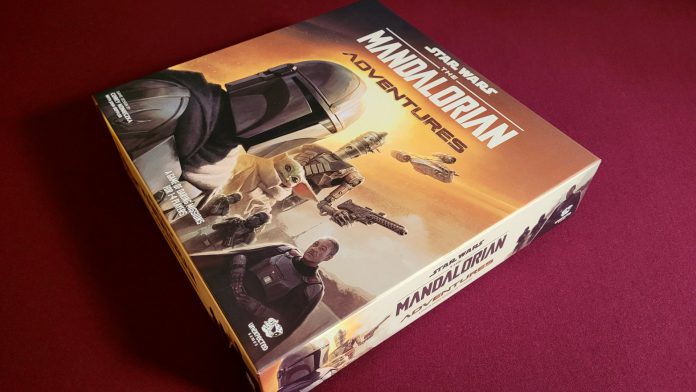With its cast of colorful characters and mission-focused plot lines, Disney’s The Mandalorian seems ideal for an adventure game, and now it has one, thanks to veteran designer Corey Konieczka (Battlestar Galactica: the Board Game, Mansions of Madness, Star Wars: Rebellion) and his publishing imprint, Unexpected Games.
The Mandalorian: Adventures is a cooperative game for 1-4 players that focuses on tactical movement. Instead of tiles or a fold-out board, it uses a spiral-bound book to present four different maps along with information for playing each of the game’s scenarios, an approach that has seen increasing popularity recently thanks to games like Sleeping Gods and Gloomhaven: Jaws of the the Lion. The Mandalorian and his allies are represented by cardboard standees (no grey miniatures to paint), and the plethora of opponents are simple counters.
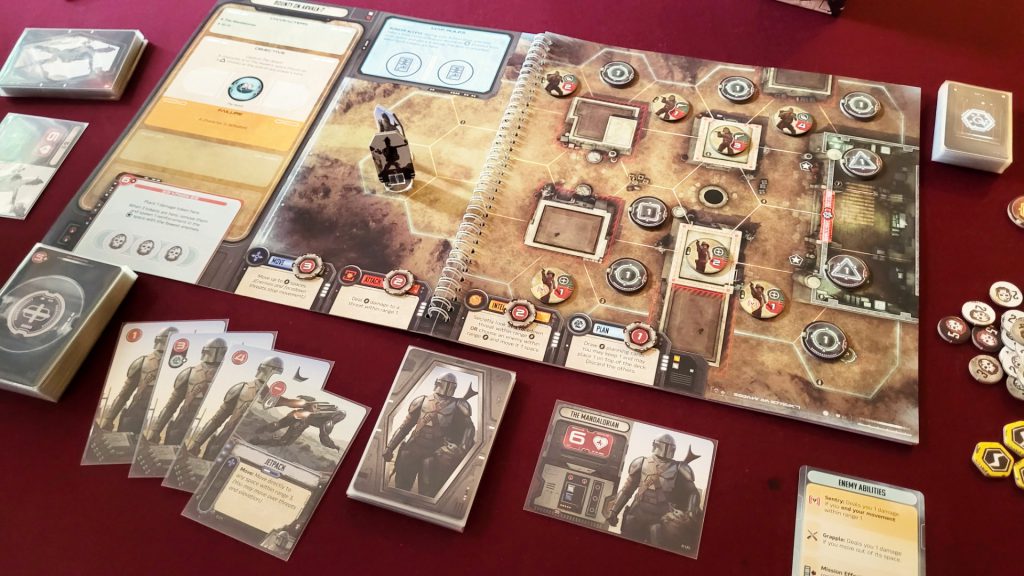
Bounty Hunting Is a Complicated Profession
On your first play-through of the game you will be greeted by the guide deck, a pre-sorted stack of cards that introduces the game’s concepts and options gradually. The cards guide you through the rule book, with the first scenario serving as a basic tutorial and then giving you some new cards to add to game’s various decks for the next game. As you play through the scenarios, you’ll unlock more new cards and various other game elements, including a pair of mysterious sealed envelopes.
In spite of this somewhat novel approach to presenting the game’s rules, I should stress that this is not a legacy or campaign game. The guide deck is intended to be a tutorial aid, but it does also give off some of the fun of a legacy game as you unlock new components. I don’t want to give too much away, but after you complete the fourth scenario, you will have a full game with several options and game modes for replaying the scenarios with different characters and win conditions. There is even an optional hidden traitor mechanism, which seems obvious coming from the designer of Battlestar Galactica, the mother of all hidden traitor games.
Setting up the game is a breeze. Each scenario comes with a set of specific tokens, and the map tells you where to place them and whether they are face up or face down. Face up tokens tend to be low-level adversaries, while scenario objectives and more powerful enemies are face down, only to be revealed when a character lands in their space, or by way of an Intel action (more on that in a moment).
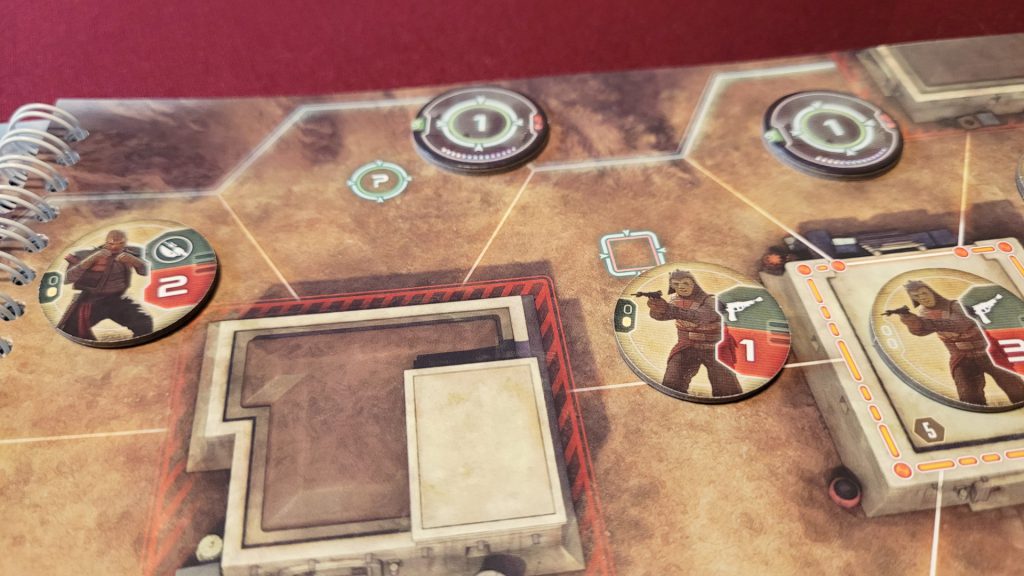
I’m Not Leaving My Fate Up to Chance
Actions in the game are governed by a clever card-based system – there are no random dice rolls to snatch defeat from the jaws of victory. Each player plays as one character, with a unique deck of cards. The bottom of the game map features a selection of available actions. On your turn, you play a card from your hand to the stack for the action you want to take. The number on the card is the strength of the action, which translates into how far your character can move or how much damage they do to a nearby enemy.
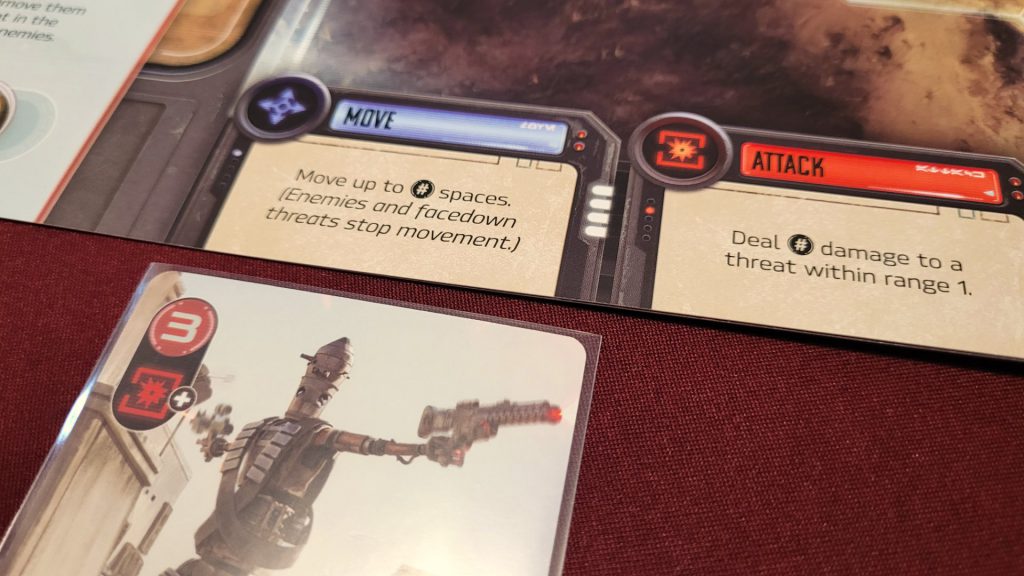
These action stacks also serve as an indicator for when enemy characters act. When the cards in any stack add up to 5 or more, an event card is drawn which instructs the players to move and/or attack with a specific type of enemy. If the stack’s cards add up to 6 or more, it also triggers what the game calls a crisis, which will spawn additional enemies or cause some other detrimental effect depending on the scenario.
This gives players an interesting decision space to operate in: your decision to take a particular action is going to be based not only on what you need to do on your turn, but also on how close each action stack is to triggering an event. The backs of the event cards show the type of enemy but not what they will do, so players have a bit of information about what’s coming to base their decisions on.
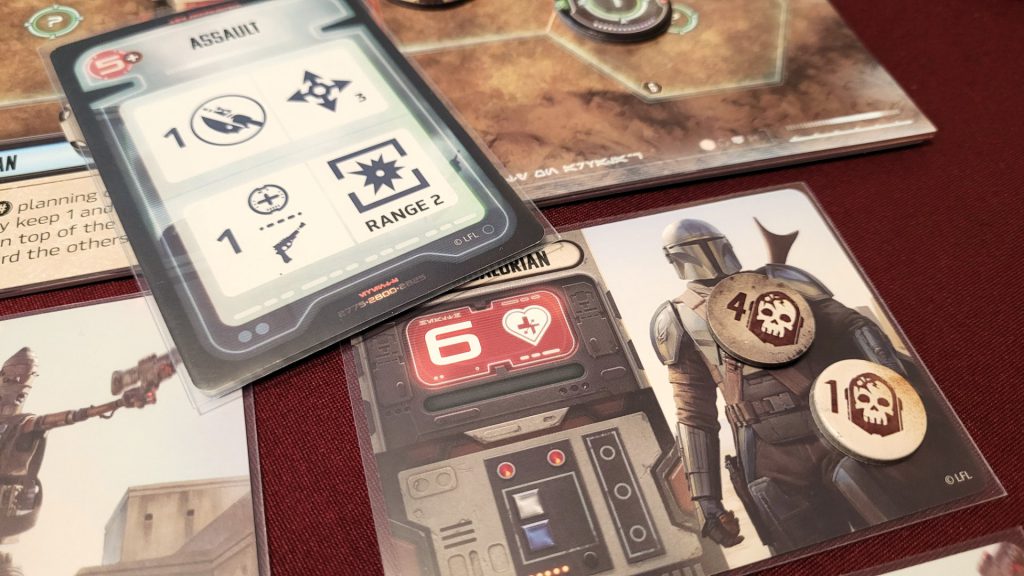
I Can Bring You in Warm, or I Can Bring You in Cold
The game’s four scenarios, all based directly on episodes from the first season of The Mandalorian, all tend to involve some variation on finding a particular objective from among the face-down tiles on the board, and then taking it to a specific space on the board. It gets a little more complicated when the objective is Grogu, who will panic and run away if the character carrying him is hit by an attack. All the while, events are triggering attacks from enemy tokens, so the game becomes a balance between finding objectives and clearing away enemy characters.

The difficulty increases a little with each scenario. For the most part the game hits that sweet spot for cooperative games between being difficult enough to feel challenging, but not so hard to win that it isn’t any fun. Players seeking a greater challenge can play on “veteran” mode which reduces their hand size by one, while for those who want an easier game, the character cards have a reverse side with more hit points.
You Are a Clan of Two
By their nature, any fully cooperative game can be played solo, but The Mandalorian: Adventures has a fairly elegant solo mode. Rather than just run a single character, you shuffle two character decks together and then play more or less as normal, with the option to play cards for either or both characters each turn.
I’ll See You Again, I Promise
I greatly appreciate the game’s straightforward rules and easy setup, which make for a refreshing change from some of the more complicated “moving guys around on a map” games out there. The components are also simple but of reasonable quality, with nice artwork and easy to read text. I don’t mind the standees in place of plastic miniatures, they are perfectly serviceable and keep the game space from getting too crowded.

The scenarios are a little on the similar side, but the game offers several options that allow for some variety when replaying them. The eight playable characters in the game all have different strengths and weaknesses, so trying each scenario with different combinations of characters should prove interesting – imagine running the climactic escape from Moff Gideon with the cast of misfits from the prison break episode.
Additionally, the unlocked features include different ways to play, as well as new scenarios that can be overlaid on the existing maps. Unexpected Games have also released several alternate scenarios that can be downloaded from their website. Even if you only replay each scenario three or four times after the initial tutorial, that’s 16-20 plays all together, not bad at all for a game at this relatively low price point.
Have any questions or feedback? Drop us a note in the comments below or email us at contact@goonhammer.com. Want articles like this linked in your inbox every Monday morning? Sign up for our newsletter. And don’t forget that you can support us on Patreon for backer rewards like early video content, Administratum access, an ad-free experience on our website and more.
